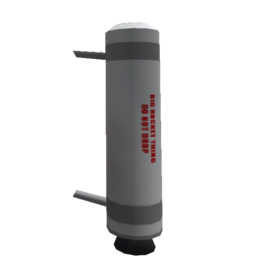Difference between revisions of "Sepratron I"
m (+wikilink;) |
(Added links to youtube videos showing the scenarios described) |
||
| Line 8: | Line 8: | ||
It can actually provide a considerably quick takeoff on a lightweight vehicle; a vessel comprised of a [[Probodobodyne OKTO2|OKTO2]] Probe and 18 Sepratron Is, and nothing else, is likely to explode due to overheating approximately 3 seconds after takeoff (upper troposphere). This is only useful for testing capsule durability (or possibly having a Kerbonaut standing atop such a vessel during a launch, if you are in a homocidal mood). | It can actually provide a considerably quick takeoff on a lightweight vehicle; a vessel comprised of a [[Probodobodyne OKTO2|OKTO2]] Probe and 18 Sepratron Is, and nothing else, is likely to explode due to overheating approximately 3 seconds after takeoff (upper troposphere). This is only useful for testing capsule durability (or possibly having a Kerbonaut standing atop such a vessel during a launch, if you are in a homocidal mood). | ||
| + | (Videos of overheating probes: http://www.youtube.com/watch?v=fXEhWbgtun4 and Kerbals: http://www.youtube.com/watch?v=XWeg7YokkKw ) | ||
However, as mentioned before, the boosters are almost weightless when empty, so the vessel should continue its upward momentum for a while. Alternatively, while in space, such boosters can be used to provide a massive boost to the same lightweight vehicle, allowing it to travel through space much faster. If ignited and detached in rapid succession, the Sepratron I is comparable to a small missile. | However, as mentioned before, the boosters are almost weightless when empty, so the vessel should continue its upward momentum for a while. Alternatively, while in space, such boosters can be used to provide a massive boost to the same lightweight vehicle, allowing it to travel through space much faster. If ignited and detached in rapid succession, the Sepratron I is comparable to a small missile. | ||
Revision as of 02:51, 2 June 2013
| Sepratron I | ||
| Solid rocket booster by Periapsis Rocket Supplies Co | ||
| Radial size | Radial mounted | |
| Cost | (total) | 75.00 |
| (dry) | 70.20 | |
| Mass | (total) | 0.073 t |
| (dry) | 0.013 t | |
| Drag | 0.2-0.3 | |
| Max. Temp. | 2000 K | |
| Impact Tolerance | 7 m/s | |
| Research | | |
| Unlock cost | 1 100 | |
| Since version | 0.17 | |
| Part configuration | solidBoosterSep.cfg | |
| Maximum thrust | (1 atm) | 13.79 kN |
| (vacuum) | 18.00 kN | |
| Isp | (1 atm) | 118 s |
| (vacuum) | 154 s | |
| Fuel consumption | 1.59 | |
| Thrust vectoring | No | |
| Burn time | (1 atm) | 3.9 s |
| (vacuum) | 5 s | |
| Testing Environments | ||
| On the surface | No | |
| In the ocean | No | |
| On the launchpad | Yes | |
| In the atmosphere | Yes | |
| Sub-orbital | Yes | |
| In an orbit | Yes | |
| On an escape | No | |
| Docked | No | |
| Test by staging | Yes | |
| Manually testable | Yes | |
| Packed volume | 25 l | |
| Stacking capacity | 2 units | |
| Solid fuel | 8 | |
The Sepratron I is a very tiny Solid Rocket Booster, though you would be unlikely to ever attempt to take off with it.
Usage
Initially, such a small Solid Rocket Booster may seem pointless, but it can be a nice addition when you are detaching stages. By placing it on the stage to be detached, rotating the part so that it is facing towards the nose of the rocket, and setting up the staging correctly, the Sepratron can work as a brake (assuming your nose is facing the direction of travel). From the perspective of the Command Module, this has the effect of 'driving' the dead stage away from the rocket, which will let it be safely cleared out of the way. If enough of them are used in this way, the detached stage can slow down enough to de-orbit. Alternatively, if you are having trouble getting a heavy plane off the runway, you may mount a few on the body to perform a rocket-assisted take-off, due to the fact when empty, they weigh almost nothing.
It can actually provide a considerably quick takeoff on a lightweight vehicle; a vessel comprised of a OKTO2 Probe and 18 Sepratron Is, and nothing else, is likely to explode due to overheating approximately 3 seconds after takeoff (upper troposphere). This is only useful for testing capsule durability (or possibly having a Kerbonaut standing atop such a vessel during a launch, if you are in a homocidal mood). (Videos of overheating probes: http://www.youtube.com/watch?v=fXEhWbgtun4 and Kerbals: http://www.youtube.com/watch?v=XWeg7YokkKw )
However, as mentioned before, the boosters are almost weightless when empty, so the vessel should continue its upward momentum for a while. Alternatively, while in space, such boosters can be used to provide a massive boost to the same lightweight vehicle, allowing it to travel through space much faster. If ignited and detached in rapid succession, the Sepratron I is comparable to a small missile.
Description
| “ | Although formerly designated as "really pretty crappy", Kerbal Scientists have slowly warmed up to the Sepratron I's many uses, such as separating things. For best results, angle before use. — Periapsis Co. Rocket Supplies |
” |
Changes
- Mass decreased from 0.2175t Full, 0.15t Empty to 0.0725t Full, 0.0125t Empty. Thrust decreased from 20kN to 18kN. Fuel capacity reduced from 9L to 8L. The Sepratron I now has the best TWR of all stock engines.
- Initial release.
